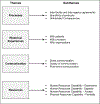Tales from the Trips: A Qualitative Study of Timely Recognition, Treatment, and Transfer of Emergency Department Patients with Acute Ischemic Stroke
- PMID: 30745000
- PMCID: PMC6467718
- DOI: 10.1016/j.jstrokecerebrovasdis.2019.01.012
Tales from the Trips: A Qualitative Study of Timely Recognition, Treatment, and Transfer of Emergency Department Patients with Acute Ischemic Stroke
Abstract
Background and objectives: Acute Ischemic stroke (AIS) is a time-sensitive emergency and patients frequently present to, and are transferred from emergency departments (EDs). We sought to evaluate potential factors, particularly organizational, that may influence the timeliness of interfacility transfer for ED patients with AIS.
Methods: We conducted semistructured interviews at 3 EDs that routinely transfer AIS patients. A structured interview guide was developed and piloted prior to use. Staff were asked about perceived facilitators and barriers to timely and high quality emergency care for patients with AIS who require transfer. Each interview was audio recorded, transcribed, coded, and analyzed using an iterative inductive-deductive approach to build a list of themes and subthemes, and identify supporting quotes.
Results: We interviewed 45 ED staff (administrative staff, nurses, and physicians) involved in acute stroke care. We identified 4 major themes influencing the execution of interfacility transfers of AIS patients: (1) processes, (2) historical experiences; (3) communication; and (4) resources. Pre-existing protocols that standardized processes (eg, autoacceptance protocols) and reduced unnecessary communication, combined with direct communication with the neurology team at the comprehensive stroke center, and the flexibility and availability of human and physical resources (eg, staff and equipment) were commonly cited as facilitators. Lack of communication of clinical and operational outcomes back to transferring ED staff was viewed as a lost opportunity for process improvement, interorganization relationship building, and professional satisfaction.
Conclusions: ED staff view the interfacility transfer of AIS patients as highly complex with multiple opportunities for delay. Coordination through the use of protocols and communication pre- and post-transfer represented opportunities to facilitate transfers. Staff and clinicians at transferring facilities identified multiple opportunities to enhance existing processes and ongoing communication quality among facilities involved in the acute management of patients with AIS.
Keywords: Emergency care, transfers; Health care delivery systems; Ischemic stroke; Qualitative methods.
Published by Elsevier Inc.
Conflict of interest statement
Figures
References
-
- Powers WJ, Rabinstein AA, Ackerson T, et al. 2018 Guidelines for the Early Management of Patients With Acute Ischemic Stroke: A Guideline for Healthcare Professionals From the American Heart Association/American Stroke Association. Stroke. 2018;49(3):e46–e110. - PubMed
-
- Ng FC, Low E, Andrew E, et al. Deconstruction of Interhospital Transfer Workflow in Large Vessel Occlusion: Real-World Data in the Thrombectomy Era. Stroke. 2017;48(7):1976–1979. - PubMed
Publication types
MeSH terms
Grants and funding
LinkOut - more resources
Full Text Sources
Medical



